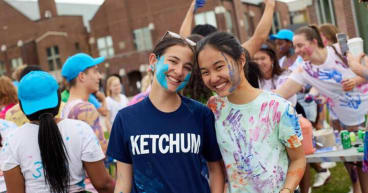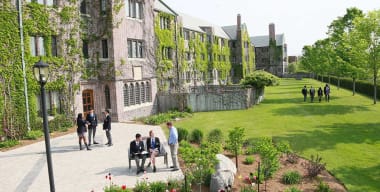Each class is assigned a four-day period and participates in a program that follows the Ontario Curriculum guidelines for that grade level. Grade 8s start arriving in the third week of September for a program based on developing canoeing, wall climbing and leadership skills. In November, December and March, the Grade 6 students explore native culture, low ropes challenges and orienteering. Following the winter holidays, Grade 7 students are immersed in a program focused on skiing, snowshoeing, animal tracking and playing in the snow. Finally, after the March break, Grade 5 students get to experience the wonder of maple syrup making, the challenge of wall climbing, the creativity of shelter building and the pleasures of nature appreciation.
For four days a week, 25 weeks of the year, Paul Stephens and I provide a dynamic outdoor education experience for the students who visit the OEC with their classroom teachers to learn about nature, themselves and others.
DAY 1
7:30 a.m. Packing for school
I pack my laptop and programming binders for the week's session. Luckily, I have a bedroom at the OEC with a bed, closet, bookcase and small night table where I keep all my clothes, books and programming materials for the school year. I move four Rubbermaid containers –labeled "Rain Gear," "Winter Gear," "Layering" and "Clothes"—to the OEC in September to hold items such as snow pants, down-filled coats, extra toques, three kinds of boots, t-shirts and loads of polypropylene-based long underwear. My small library of nature guidebooks and lesson plans is carted to the OEC in milk crates and boxes. Students visiting the OEC receive a packing list based on the time of year they're at the OEC. In addition to important things such as a sleeping bag and a pair of outdoor shoes (rubber boots or well-insulated winter boots), students are reminded about items to leave at home, such as electronics and food.
7:45 a.m. On the road
I leave my Mississauga, Ontario home for the 179 km drive to the Mentor College/TEAM School OEC, picking up Paul in Barrie en route. (After seeing the gridlock of southbound traffic, I feel lucky that my commute and work means leaving behind the hustle and bustle of city life!) Paul and I share programming ideas and plans for the week on the drive up, guided mostly by the weather forecast. We cross reference with Environment Canada and the Weather Network and choose lessons based on whether they can be taught in the rain. We also plan according to the grade level and the number of visiting students. We try to keep the grade level programs the same, so that all students in Grade 8, for example, whether they visited the OEC in September or late November, can experience the same team-building, climbing wall, night hike and nature hike activities.
9:45 a.m. "Classroom" prep
We arrive at the OEC, quickly settle in, then spend an hour and half or so getting ready for the afternoon session.
- Setting up tables and chairs for meals
- Reading over student medical information forms to familiarize ourselves with any issues (asthma and allergies requiring puffers and epi-pens)
- Making adjustments to the day's lesson plan (this week is cold and rainy, so we decide to run some of the team-building activities indoors)
- Checking to make sure my radio is charged, my backpack is stocked with my whistle, water bottle, extra gloves and a first-aid kit containing items like Band-Aids, peroxide and an extra epi-pen
- Getting out programming materials as well as two green 9-foot x12-foot tarps, three buckets filled with Mr. Potatohead parts and a whiteboard materials needed for the afternoon team-building lesson
- Bringing out two Rubbermaid bins jammed with an assortment of rain gear
OE teacher tip: A stockpile of essential items like rain gear, extra gloves and mitts, toques and rubber boots really helps make our program run more smoothly since a student or two inevitably forgets something on his or her packing list, or their only pair of gloves gets soaked while playing an outdoor game.
11:40 a.m. Student arrival
I greet the busload of 34 Grade 8 students and their two classroom teachers, go over arrival procedures, get the students to unpack the bus, then shepherd them upstairs to eat their bag lunches.
12:00 noon Lunch and learn
While the students eat lunch, we go over the OEC rules and responsibilities. It's challenging because there's a lot to discuss from what bunkroom they'll be sleeping in to how a septic system works and how using the OEC water system is different from the one at home. As we go along, we ask students to share with the rest of the group what they can remember of the OEC procedures. Even though most of these Grade 8 students have been to the OEC before, they still need to be reminded of the OEC routines and rules and how they are different or similar to the rules at school, home and summer camp. This also helps remind or inform the visiting classroom teachers as well, so that they model and enforce the OEC expectations.
Examples of rules and responsibilities:
- Chores: Besides looking after their personal bunk and belongings, each student is assigned two daily chores: table setting and clearing duty, and bunkroom and bathroom clean up.
- Homework: Students work with their teachers for one hour every night.
- Showers: Because of the high-tech water purification system, students can shower only once while at the OEC. Showers are scheduled before and after meals and each student is assigned a time.
- Bedtime: Students start getting ready for bed at 9:30 p.m., with lights out at 10:00 p.m.
1:30 – 4:45 p.m. Session One: Leadership
After unpacking their bags and getting settled into one of the four assigned bunkrooms, and a bit of supervised free time outside, the group gathers at the campfire pit. OE teacher tip: Students don't wear school uniforms this week, but they need to dress appropriately for outdoor activities. Before starting the afternoon session, we introduce Timmy and Suzie, small paper doll-like mascots/teaching tools. Inappropriately dressed Timmy wears shorts, a t-shirt and a baseball hat. Suzie sports a warm, fuzzy sweater, rain pants, boots and a toque. Throughout the week, before we start any outdoor activity, we remind students to lead by example and to "be a Suzie."
A series of experiential activities and lessons teach the Grade 8s about the school motto: "leading by example." Upon returning to school, it is hoped that they will model it to the rest of the intermediate division. Team-building lessons encourage students to work together to complete a number of initiatives such as the carpet maze, where communication and honing of individual strengths gets their whole team through the invisible maze first, and the tarp shrink, where teams of 12 to 17 students work together to stay standing on a tarp that shrinks in size by half after every round. The latter focuses on listening, communication and recognizing different types of emotional, physical and environmental barriers. These team-building activities prepare the group for their experience with the low ropes course and the climbing wall later in the week.
4:45 – 6:30 p.m. Dinner, duties and diversions
The menu is the same each week and is chosen for kid-appeal, as well as being easily modifiable for students with dietary concerns. Once dinner is done, tables cleared, and bedroom and bathroom clean up completed, students have free time to play indoor games or hang out in their bunkroom.
OE teacher tip: To avoid cliques forming or issues arising, we have a rule that both boys and girls are seated at each table. We also encourage students to sit with different people each mealtime. There is a separate table for teachers where we discuss the success of the activities and any concerns that might have arisen, and also enjoy some time chatting with our colleagues. During mealtimes, especially during lunch and dinner, it can become pretty noisy with students talking about the day's events and enjoying one another's company.
6:30 – 7:30 p.m. Homework
While classroom teachers supervise homework time, Paul and I start making the special take-home memento presented to each student on the last night as a keepsake and reminder of his or her contribution to the group. We also prepare for the evening's activity and make a quick phone call to our families.
8:00 p.m. Evening Program: Skit night and charades
Skit night is a tradition at the OEC, but we add variety with annual modifications. In their small groups, students come up with characters to fit the hats they were given and create a skit that portrays and completes the sentence: "and the moral of the story is" Once the skit is over, the audience guesses the moral of the story (skit).
After lights out
With the classroom teachers, Paul and I ensure students are settled for the night then he and I empty the dishwasher, wash the snack dishes, download photographs taken during the day (for the big wrap-up evening program on our last night) and continue preparing for tomorrow's activities. I lay out the materials for the animal survival game, while Paul prints off the sheets to be filled for the "Choose Your Own Adventure" scavenger hunt. In groups, students follow a map to find and solve a variety of clues and puzzles based on different topics, such as science, math and geography, hidden throughout the OEC property.
Next day's plans–always weather-permitting!–also include two hikes: a day walk along the 'Beaver Pond' trail that leads by a waterfall, an old beaver pond and through new- and old-growth forest areas, and a night trek that focuses on three different local, nocturnal animals and which of the five senses they have adapted for survival in dark conditions.
DAY 4
Homeward bound
After two more 7:00 a.m. to 11:00 p.m. teaching days, a last morning with the kids and final clean up of the building, Paul and I pack up and head home. Around 2:45 p.m., exhausted from the week, I plop down on my couch with a cup of tea and the newspaper but by Tuesday morning, I'm ready to do it all over again!
Student comments
The leadership challenges were really fun. The maze initiative was difficult, but in the end we pulled it off and won. I learned that sometimes you do need help from other people. —Dani, 12
I thought skit night was even more fun this year because we had to create characters with different hats. —Casey, 12
I have always loved the [animal] survival game! —Emily, 13
The Bat and Moth game was a fun way of experiencing how nocturnal animals live and hunt. While hiking, it was interesting to be involved in nature, in the dark! —Fatimah, 12
Rock climbing was very fun at the OEC this year! We learned how to belay each other. I climbed the overhang wall and hung from the wall with the bottoms of my feet flat on the wall I wasn't even holding on to the wall! —Adrianna, 12
The OEC is my home away from home. I learn so many new things, playing games and doing outdoor activities. I have learned to become a better leader and a stronger person. At the OEC I always have the greatest learning experience! —Katrina, 13








